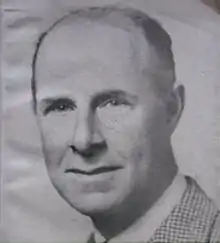Pierre Lecomte du Noüy
Pierre Lecomte du Noüy (French pronunciation: [ləkɔ̃t dy nwi];[1] 20 December 1883, Paris – 22 September 1947, New York City) was a French biophysicist and philosopher. He is probably best remembered by scientists for his work on the surface tension, and other properties, of liquids.

Life and work
Du Noüy was a descendant of the French dramatist Pierre Corneille. His mother wrote many novels, one of which, Amitié Amoureuse, was translated into 16 languages and ran for 600 editions in France. Born and educated in France, du Noüy obtained the degrees of LL.B., Ph.B., Sc.B., Ph.D., and Sc.D.
He was an associate member of the Rockefeller Institute working in Alexis Carrel's lab from 1920 through 1928, head for 10 years of the biophysics division of the Pasteur Institute,[2] and the author of some 200 published papers.[3]
He invented the Tensiometer,[4] a scientific apparatus that used his du Noüy ring method to measure the surface tension of liquids.[5]
Du Noüy believed that mankind should have confidence in science, but be aware that we know less about the material world than is commonly believed.
Telefinalism
Du Noüy converted from agnosticism to Christianity. He supported a theistic and teleological interpretation of evolution.[6] In his book Human Destiny he wrote that biological evolution continues to a spiritual and moral plane.[6] Du Noüy met Pierre Teilhard de Chardin who shared similar interests in evolution and spirituality.[7]
Du Noüy developed his own hypothesis of orthogenesis known as "telefinalism".[8] According to Du Noüy evolution could not occur by chance alone and that on an average since "the beginning of the world it has followed an ascending path, always oriented in the same direction." He accepted naturalistic evolutionary mechanisms such as mutation and natural selection but believed science could not explain all evolutionary phenomena or the origin of life.[9] According to his telefinalist hypothesis a transcendent cause which he equated with God is directing the evolutionary process.[6]
His "telefinalist" hypothesis was criticized by Carl Hempel,[10] Leo Koch and George Gaylord Simpson as nonscientific.[6][11]
Publications
- Between Knowing and Believing (1967)
- The Road to Reason (1948)
- Human Destiny (1947)
- Biological Time (1937)
- An Interfacial Tensiometer for Universal Use (1925). The Journal of General Physiology. Volume 7, issue 5, pp. 625–633
Quotes
If telefinalism, by postulating the intervention of an Idea, a Will, a supreme Intelligence, throws a little light on the combined transformations leading through an uninterrupted line to Man, it seems impossible not to see in the particular transformations limited to the species something more than the simple play of physico-chemical forces and chance. Human Destiny, p. 97
See also
References
- Forvo.com
- Reese, William (1996). Dictionary of philosophy and religion : Eastern and Western thought (New and enl. ed.). Atlantic Highlands, N.J.: Humanities Press. p. 401. ISBN 0391038648. OCLC 33983842.
- Ockenga, Harold J., Journal of the American Scientific Affiliation, May 1949.
- Fisher Scientific Co. (1973). Fisher Surface Tensiometer Model 20 Instruction Model (PDF) (7th ed.). Pittsburgh, Pennsylvania. p. 4.
{{cite book}}: CS1 maint: location missing publisher (link) - "Peter Sellers: A Pioneering Mathematician, A Renaissance Man". The Rockefeller University Digital Commons. March 2017. Retrieved 31 May 2018.
- Simpson, George Gaylord (1964). This View of Life: The World of an Evolutionist. Harcourt, Brace & World, pp. 217–223.
- Shuster, George Nauman, and Ralph E. Thorson (1970). Evolution in perspective: commentaries in honor of Pierre Lecomte du Noüy. University of Notre Dame Press, p. 268.
- Huggett, Richard (1998). Catastrophism: Asteroids, Comets and Other Dynamic Events in Earth History. Verso, p. 102.
- Halbach, Arthur Anthony (1948). The Definition of Meaning in American Education. Cath. University of Amer. Press, p. 8.
- Hempel, Carl (1950). "Problems and Changes in the Empiricist Criterion of Meaning". In Revue Internationale de Philosophie 11:42.
- Koch, Leo (1957). "Vitalistic-Mechanistic Controversy", The Scientific Monthly',' Vol. 85, No. 5, pp. 245–255.
Further reading
- Mary du Noüy (1955). The Road to Human Destiny: A Life of Pierre Lecomte Du Noüy. Longmans, Green.
- George Nauman Shuster, Ralph E. Thorson (1970). Evolution in Perspective: Commentaries in Honor of Pierre Lecomte du Noüy. University of Notre Dame Press.